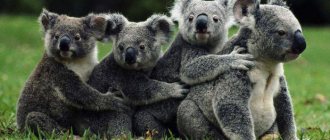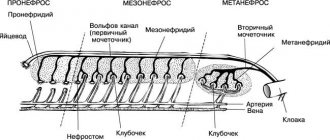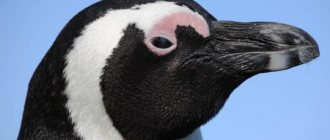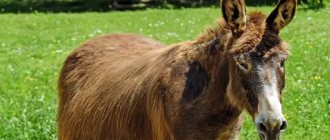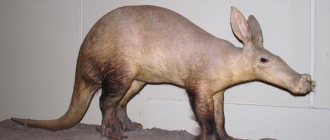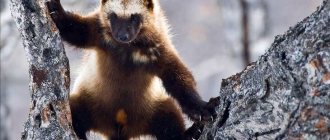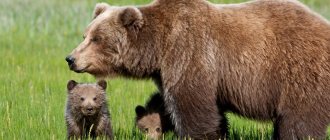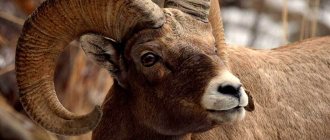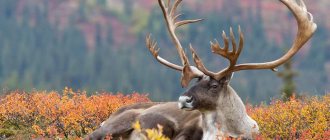Canada is considered one of the world's largest countries in terms of area. The extraordinary and wonderful nature attracts many tourists who want to enjoy the wild nature of Canada.
The country's natural complexes have been preserved in their pristine natural state, despite the fact that they are very close to modern large populated areas. Approximately 10 of the country's area is wild, untouched nature. Local residents are very proud of their natural complexes and protect them in every possible way. Here you can find many rare representatives of flora and fauna.
National animals of Canada
The official coat of arms of Canada
The national flag of Canada features a maple leaf, but no animals. However, another national symbol of Canada, the coat of arms, contains representatives of the fauna.
The top of the Canadian coat of arms features a crowned lion with a maple leaf in its right front paw, flanked by a lion and a mythical animal, a unicorn, holding a shield.
In addition, Canada has two main national animals - the Canadian beaver and the Canadian horse.
Canadian beaver
The Canadian beaver is a large, nocturnal, semi-aquatic rodent known for building lodges, canals and dams. It is the second largest rodent in the world, but the beaver population in North America has been steadily declining due to extensive hunting (primarily hunted for fur and beaver pelts).
The beaver appeared on the coat of arms of North America's oldest commercial corporation, the Hudson's Bay Company, and on the first postage stamp issued in the Canadian colonies in 1849. In addition to being the national animal, the beaver is a symbol of many associations, organizations and departments. Today, the image of a beaver is found on the coat of arms of some Canadian provinces and on 5-cent coins.
Flora of the state
Vast areas of the country are occupied by natural formations such as taiga and tundra. In tundra zones, vegetation belongs to dwarf species. Shrubs and various herbs grow on this land.
The taiga is rich in coniferous and deciduous trees. Canadian maples, from which the notorious maple syrup is made, are the pearl of these forests. Mixed tree zones predominate among Canadian forests.
Beech, fir, red spruce, cedar and hemlock are unique trees in Canada, which are rare in the world and are of great interest to researchers.
It is worth knowing that there are really a lot of national parks and botanical gardens in the country. Canada is considered the leader among countries in terms of the number of territories uncultivated by humans.
Pygmy chain rattlesnake
The snake, seen in marshy areas and grasslands, is found in the southeast and southern parts of Canada. It is dangerous if a person gets too close to it or steps on it without noticing. In this case, a representative of the viper family bites and secretes poison, which has a pronounced damaging effect on the nervous system. Fatal consequences include hemorrhage in the internal organ systems, provoked by a blood clotting disorder.
Map of Canada. Geographical characteristics
Canada is a North American state whose shores are washed by three oceans - the Arctic, Atlantic and Pacific.
Canada has the longest coastline of any country (202 thousand kilometers), and also ranks second in total area (almost 10 million km2).
Administratively, Canada is divided into 3 large territories and 10 provinces. Most provinces have a predominantly English-speaking population, with the exception of Quebec, where almost everyone speaks French. This is due to the fact that Quebec was the first French colony at the beginning of the 17th century, when Europeans explored the New World.
A detailed map of Canada allows you to estimate the size of the country and its geographical features. The country is interesting for the presence of many rivers and lakes, as well as a cool climate similar to Russia.
Accommodation
Canada is one of the most developed and prosperous countries on the world map, so there is a very high demand for rental housing here.
Suggested housing rental options:
An apartment in a multi-storey building is the most inexpensive option for renting residential premises. In big cities, renting a one-room apartment will cost from 52,000 rubles. per month. Accommodation in a two-room apartment will cost 62,000 rubles. per month.
A detached house is the most expensive housing. Such rental houses are most often built on two floors: on the lower floor there is a kitchen and a room for receiving guests, on the upper floor there are bedrooms. There must be a garage. Renting a one-story small house will cost 100,000 rubles. per month, three-room apartment - about 200,000 rubles. per month, two-story - from 300,000 rubles. per month.
A townhouse is a long two-story building divided into sections, each of which is a residential building. The area of one section of a townhouse is less than the area of a separate house. Utility costs for those renting a townhouse are much lower than in a detached house. The average rent is 90,000 rubles. per month.
It is not often that you come across a duplex - a two-story private house divided into 2 halves, each of which is rented separately. Rent amount from 120,000 rubles. per month.
Table of temperatures in different cities
| Temperature | ||||||
| City | Absolute minimum, °C | Winter (3 months), °C | Average annual, °C | Summer (3 months), °C | Absolute maximum, °C | Average annual precipitation, mm |
| Brandon | −46,6 | −15,3 | +2,4 | +17,8 | +43,2 | 473 |
| Vancouver(port) | −15,5 | +5,2 | +11,0 | +17,4 | +32,6 | 1588 |
| Victoria | −11,1 | +5,8 | +10,3 | +15,2 | +30,4 | 698 |
| Winnipeg | −44,9 | −15,3 | +2,6 | +18,3 | +40,5 | 513 |
| Halifax | −26,0 | −3,3 | +7,2 | +17,6 | +33,9 | 1507 |
| Hamilton | −25,1 | −2,4 | +9,3 | +21,0 | +38,4 | 750 |
| Iqaluit | −45,5 | −26,1 | −9,8 | +6,0 | +25,7 | 411 |
| Yellowknife | −51,1 | −24,6 | −4,6 | +14,8 | +32,4 | 280 |
| Calgary | −44,9 | −7,5 | +4,1 | +15,2 | +36,0 | 412 |
| Quebec | −36,0 | −11,0 | +4,0 | +17,9 | +35,5 | 1229 |
| Kelowna | −32,1 | −1,0 | +9,0 | +19,3 | +39,9 | 339 |
| Montreal | −37,7 | −8,3 | +6,2 | +19,5 | +37,5 | 978 |
| Ottawa | −38,8 | −8,6 | +6,3 | +19,7 | +37,7 | 913 |
| Regina | −47,1 | −14,5 | +2,3 | +17,4 | +43,8 | 377 |
| Saskatoon | −43,8 | −14,3 | +2,5 | +17,3 | +40,9 | 349 |
| Saint John | −36,6 | −6,7 | +5,0 | +16,0 | +34,3 | 1389 |
| St. John's | −23,7 | −4,2 | +4,7 | +14,2 | +31,4 | 1513 |
| Toronto | −32,7 | −2,8 | +9,1 | +20,9 | +40,5 | 833 |
| Whitehorse | −51,1 | −15,4 | −0,2 | +13,5 | +35,5 | 282 |
| Winsor | −29,0 | −3,1 | +9,4 | +21,5 | +40,1 | 917 |
| Fredericton | −37,1 | −8,1 | +5,3 | +18,0 | +37,1 | 1142 |
| Charlottetown | −30,5 | −6,2 | +5,7 | +17,5 | +36,6 | 1170 |
| Edmonton | −48,2 | −9,9 | +3,9 | +16,5 | +34,4 | 476 |
Saltwater crocodile
The largest among crocodiles are combed crocodiles, which live in Australia, India, Indonesia, and Indochina. The length of their bodies can reach up to 6.2 m, and the mass of such crocodiles can exceed a ton. Due to their size, saltwater crocodiles are considered the largest reptiles and terrestrial predators on the planet.
Saltwater crocodiles are extremely dangerous and are capable of attacking even some types of sharks in the water. In nature they have no natural enemies. Even a person with a firearm has a hard time resisting them. An indicative incident occurred in February 1945 on Ramri Island. During the Second World War, an armed detachment of more than a thousand armed Japanese tried to get out of encirclement by making their way through one swamp. As a result, almost all the soldiers were eaten by saltwater crocodiles, only 20 Japanese survived.
Soils
In Canada, the most common soils are podzolic soils, which are usually infertile. They predominate in the tundra and the vast zone of coniferous forests located to the south. In areas where there is less precipitation, and it occurs mainly in the summer, highly fertile chernozems are formed, unusually suitable for agriculture (the Winnipeg-Edmonton-Calgary triangle). Coniferous forests give way to vast prairies. Where there is less than 330–360 mm of precipitation per year, chestnut soils are formed, which are widely used in agriculture. High yields here can be obtained in wet years and with the help of irrigation. To the south, grayish soils are common, characteristic of arid regions.
Minerals in Canada
A huge amount of natural resources is hidden in the Canadian depths. The country boasts the following gifts of nature:
- Non-ferrous and rare metals;
- Iron ores;
- Coal and natural gas;
- Large oil reserves;
- Asbestos and uranium;
- Potassium salts and much more.
Canadian industry operates on the resources of its own country, without the need to purchase materials from other countries. The luxurious Canadian nature is a separate attraction of Canada, for which thousands of tourists come to the state.
Wolf
The wolf is one of Canada's most dangerous animals. In harsh conditions, when there is not enough food in the natural environment, wolves approach people's houses, steal chickens, and attack livestock. Attacks on humans are rare; wolves prefer to avoid direct confrontation and confrontation. However, if you notice that the animal has gotten into the habit of often going into the yard and living in close proximity to the house, you should be seriously wary. Under such circumstances, a wolf may lose its sense of fear of a specific person and attack. In these cases, a forced hunt opens for the predator.
Flora and fauna of Canada photographed by National Geographic
National Geographic magazine was founded in October 1888 and is considered one of the most popular publications about geography, nature, history, science and culture. NG photographers travel around the globe in search of amazing images. Their findings fascinate, surprise, frighten, and delight. Thousands of authors send their photos to the editor in the hope that they will be appreciated. Strict judges select the best photographs and show them to the whole world.
1. Elk swimming in a lake, Jasper National Park, Alberta National Geographic Photo Contest/Cathy Parsons
2. A Canadian black wolf roams the shores of Moers Island in British Columbia. National Geographic Photo Contest/Mark Bridger
3. Mass autumn migration of Canada geese. National Geographic/Thomas Kitchin & Victoria Hurst/Getty Images
4. British Columbia, humpback whales playing ten meters from the boat. Matthew Thornton/National Geographic Traveler Photo Contest
5. Yellow spider on a yellow flower in Dorset, Ontario. National Geographic Photo Contest/Jeremy Crawford
8. Photo taken near the glaciers of Arctic Bay, Nunavut. The highest human balloon flight at this latitude. It's actually one iceberg, but it looks like two. Michelle Valberg/National Geographic Traveler Photo Contest
9. Muskoka, Ontario. Alessandro Cancian/National Geographic Traveler Photo Contest
11. View of Sunburst Peak on an autumn morning on the border of British Columbia and Alberta. Henry Liu/National Geographic Traveler Photo Contest
12. Autumn Park, Toronto, Ontario. Amirhassan Farokhpour/Nature/National Geographic Photo Contest
15. Red Deer River in Alberta. Google, Cnes DigitalGlobe, Spot Image
Source
Where to go with children?
The Canadian metropolis of Vancouver is ideal for families with children. You should definitely visit the Olympic venues here.
The famous Vancouver Aquarium includes:
- marine inhabitants of the Arctic seas;
- inhabitants of the Pacific Ocean;
- Treasures of the Pacific Coast;
- tropical rainforest zone;
- exhibition of amphibians.
Stanley Park has a zoo, an interesting collection of totems of Indian tribes, and a miniature railroad.
In the city of Hamilton, which is located in the province of Ontario, there is an African Lion Park where animals move freely. The city also recommends for family visits the country's military history museum and the ancient Dundurn Castle , which was once the residence of the Canadian Prime Minister.
When in Montreal with children, you should definitely visit the Biodome, a large indoor park that displays reconstructed models of all the natural zones of the Earth. There is also a Botanical Garden, which is illuminated at night. In Montreal, the whole family will be interested in visiting the Doll Museum and the Museum of Indian Art.
In summer, you should definitely go to the Fireworks Festival.
basic information
According to the latest data, Canada's population is more than 36 million people. Most of the state's residents live in the southern regions and cities. A significant share of population growth is provided by immigration (the entry of foreign citizens into the country).
According to the latest census, representatives of 43 ethnic groups live in the country, the most numerous among them:
- Canadians are European settlers who have lived in the country for more than 100 years;
- Europeans (English, French, Scots, Irish, Germans, Italians, Russians);
- Asians (Chinese, Indians, representatives of Middle Eastern countries);
- indigenous people (Indians, Eskimos).
The country's currency is the Canadian dollar; 1 Canadian dollar costs 50.5 rubles.
During the development of Canada, two states fought for its territories: England and France. Therefore, the official official languages of the country are English and French. Politicians and government officials are required to be fluent in English and French. All important government documents are prepared in 2 languages.
Residents of multiethnic Canada profess the following religions:
- Canadians and Europeans - Christianity (Catholicism and Protestantism);
- representatives of Asian nationalities - Buddhism, Islam, Hinduism, Judaism;
- indigenous peoples are pagans.
The time difference between the eastern part of the state and Moscow is 8 hours. The west of the country has an eleven-hour time difference with Moscow.
Water bodies and their influence on the weather
Canada is washed by 3 oceans. All of them have a significant impact on the country’s climate.
The Arctic Ocean further cools the north of the continent. Impact of the Pacific Ocean on the western shores and about. Vancouver moderates the climate and makes it more temperate and rainier in winter. The Atlantic Ocean partially softens the winter in the southeastern regions, but increases the amount of precipitation and causes heavy snowfall.
Canada is well endowed with water resources. There are more than 2,000,000 lakes here and 20% of the world's freshwater reserves are concentrated. The Great Lakes, connected by small rivers, cover an area of more than 240,000 km². The famous Niagara Falls is located on the border with the United States.
Relief of the country
The center and east of the country are occupied by plains. The Cordillera mountain range stretches in western Canada. The entire territory of the state is covered by a network of small and medium-sized rivers, as well as large lakes. The country's hydropower reserves exceed all similar reserves in the world.
The cultivated black soil of the state is located in the south. There in Canada, active agricultural work is underway. Most forested areas in Canada are in the west.
Logan Summit is considered the highest point in the Canadian mountains. Its peak reaches 5959 meters into the sky.
The Mackenzie is the longest river in Canadian lands. The length of the water artery is 4,200 km.
Great Bear Lake is the largest lake in the state. Its area is estimated at 30,200 square meters. km.

